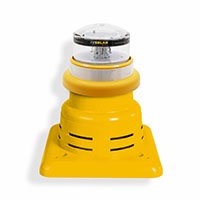
IVSOLAR: New Website with exclusive utilities
On the occasion of the launching of the new generation of signaling beacons, IVSOLAR release a new website too. Clearly…
+ info
Electrical poweredbeacon, designed for use in meteorological and telecommunications towers, cranes, chimneys, bridges, wind turbines or any structure up to 45m high, as well as in airports, marinas and ports.
With the “UPS-BACKUP” option, it can continue to function in the event of a power cut (see autonomy).
It has the ICAO STAC certification for Type A low intensity beacons.
 Low intensity <45m
Low intensity <45m
 Intensity 10Cd
Intensity 10Cd
 Electric
Electric
Power source: Electrical connection (110-240VAC, or 12-30VDC).
Indicated for: Signaling of obstacles up to 45m high.
Autonomy (with “UPS BACKUP” option):
With steady light (ICAO Type A): 100 hours (starting from a 100% charged battery)
With flashing light (30 DPM): 500 hours (starting from a 100% charged battery)
Attention: The autonomy of the battery can be affected significantly depending on the weather conditions.
Configurator: Remote “IV-CRF” configurator option to change the mode and/or operation of the beacon.
Light colors: Red (standard), White, Amber, Green, Blue.
Mode: Fixed light / Flashing light.
Operation: Only night / 24h.
Twilight sensor: Integrated.
Flash synchronization: GPS synchronization option.
Fault alarm: Option, through “Dry contact” connectable to datalogger.
Telecommunications: It can be integrated into the “IV-Manager System” environment for beacon management and monitoring from a remote location.

Fijación lateral:
Fijación a tubo vertical (20 a 60mm de diámetro) o a pared.

“New Jersey” horizontal fixing:
For horizontal support (floor, wall crest, etc…).

“Fence” horizontal fixing::
For an horizontal structure (cranes, fences, etc…)

Fixation for aerodrome/airport deflector (45º inclination):
Special for runway head deflectors in aerodromes and airports.

Cone support for fixing on the ground:
Used in aerodromes/airports, mines, etc. It can be attached to the ground with screws.
Complete the form and we will contact you as soon as possible.

On the occasion of the launching of the new generation of signaling beacons, IVSOLAR release a new website too. Clearly…
+ info
According to ICAO International Civil Aviation Organization, a body overseeing International Civil Aviation Safety, tall aviation obstacles as Antennas, Telecom…
+ info